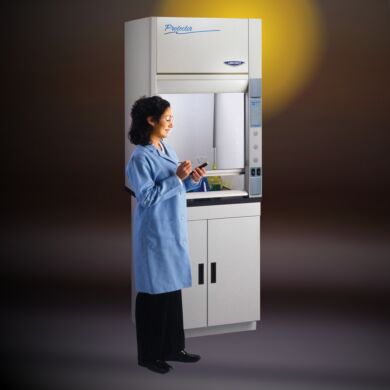- (714) 578-6016
Hours Mon - Fri, 07:00 AM - 06:00 PM (Pacific Time)
Worldwide Pricing and Secure Global Shipping Available!
- Get a QuickQuote
- Free Consultation (714) 578-6016
- Track Order Sorry, no orders are open for tracking
- Home
- Fiberglass 30 Laboratory Fume Hood from Labconco

Product Group:
3646-PP-03
3646-PP-03 71376
Fiberglass 30 Laboratory Fume Hood from Labconco
Read more



Manufactured By: Labconco
Print
Want a quote quickly ?
Submit a QuickQuote requestProduct Details
Product Details
Product Details
- 30”-wide benchtop ventilation hoods featuring a one-piece, molded fiberglass interior for corrosion- and fire-resistance
- Fits on crowded workbenches or can be placed on a Labconco storage cabinet
- Interior materials feature a flame spread index of less than 25 per ASTM E-84
- Bypass airflow design maintains stable face velocity as the sash is closed
- Radius corners eliminate cracks where contaminants can collect
- Pivoting air foil is easy to clean and promotes smooth airflow
 Fiberglass 30 Laboratory Fume Hood
Fiberglass 30 Laboratory Fume Hood
Fiberglass 30 Laboratory Fume Hoods are compact and provide ventilated work spaces | 3646-48 displayed Fiberglass 30 Laboratory Fume Hood The compact Fiberglass 30 Laboratory Hoods are designed for research, educational and clinical applications requiring small working space and efficient fume removal
Features & Benefits
Features & Benefits
Learn More: Fume Hoods
Print Copy Copied
Fume Hood Frequently Asked Questions
Selecting the appropriate fume hood or ductless exhaust hood, ensuring operator protection, and maintaining optimum hood performance can be a monumental task. Asking the right questions will help drive your decision-making process toward the right system for your application and support your standard operating procedures in maintaining a safe environment.
Does my work require a fume hood?
Use of a chemical fume hood is required to enclose work involving toxic gasses, reactive or explosive materials, volatile chemicals, carcinogens, flammable chemicals, hazardous substances and processes producing aerosols or nuisance odors.
What’s the difference between a ducted fume hood and a ductless exhaust hood?
Exhaust fume hoods vent air from the work area directly outside of the building by connecting to the facility’s ducted exhaust system. Ductless exhaust, or stand-alone, fume hoods use integral blowers to draw air away from the work area through a set of filters before safely releasing the air back into the ambient lab. Ductless hoods commonly use a two-stage filtration system composed of a charcoal filter for vapor containment and a final HEPA filter for particle containment. Charcoal filters capture chemical vapors with varying degrees of efficiency; review your list of chemicals - along with solvent concentrations and aliquoted volumes - with your fume hood specialist to ensure the appropriate filter is purchased. Laboratory fume hoods are required to safely enclose chemicals, such as methanol, that are not captured efficiently by charcoal filtration. Small-footprint ductless fume hoods fit onto crowded benchtops or into areas of the lab without access to the facility exhaust system. The effectiveness of a ductless exhaust hood is contingent upon regular filter maintenance; talk to your hood specialist or EH&S representative to prepare a standard filter replacement schedule.
What’s the difference between DH I, DH II, and DH III?
These acronyms define the different types of ductless hoods outlined by The Scientific Equipment and Furniture Association (SEFA):
- Ductless Hood I (Type I): These light duty exhaust hoods are equipped with filtration only suitable for non-toxic chemicals, nuisance odors and particulates. They are not required to have a warning sensor for chemical breakthroughs.
- Ductless Hood II (Type II): This type of fume hood meets all DH I requirements, and can filter manufacturer approved toxic contaminants, making it suitable for toxic or hazardous applications. It also includes a chemical detection sensor and alarm in the event of chemical breakthrough beyond the filter. However this design does not provide secondary containment in the event the primary filter fails.
- Ductless Hood III (Type III): This filtered fume hood is equivalent to a DH II with the added benefit of backup secondary filtration that is the same type and efficiency as the primary filter. DH III hoods also include a sensor between the primary and secondary filter, to ensure secondary filtration is available in case the primary filter fails.
Do I need a light duty chemical hood or a high-performance fume hood?
Although the primary purpose of a laboratory fume hood is operator safety, demand has increased for hoods designed to carry lower operating costs and reduced environmental impact. As fume hoods consume an average of 70,000 cubic feet of pre-conditioned air per hour, their operating costs are tied primarily to their air consumption, cited as volumetric rate (CFM) or face velocity (fpm). High-performance fume hoods - also called green ventilation hoods, high efficiency hoods or low-flow hoods – provide the highest level of containment at the lowest operating cost. High-performance fume hoods are designed to safely operate while maintaining a face velocity of 60 fpm, the lowest acceptable ASHRAE performance standard as outlined by SEFA. In addition to reduced face velocities, high efficiency fume hoods can integrate with Variable Air Volume (VAV) building automation systems to ensure minimum allowable room air changes, safe room pressurization and desirable temperature and humidity set points. A conventional light-duty, or by-pass, fume hood carries a lower up-front cost than a high-performance hood, but does not include design features allowing for reduced air volume ventilation or VAV integration. Most light-duty exhaust hoods safely operate at face velocities between 90 – 110 fpm, equal to an increase in air consumption of 30 – 50% annually. To decide between a light-duty chemical hood and a high-performance fume hood, a life cycle cost analysis is required to compare energy cost, ambient climate conditions and usage rate.
Does my work require a benchtop fume hood, walk-in hood or canopy hood?
Bench top fume hoods are mounted on an existing work surface, or casework, to create a negative-pressure environment for fume containment. A walk-in fume hood, or floor-mounted hood, includes no work surface or cabinetry, allowing the user to place large items into the hood at floor level. A canopy fume hood is installed on the wall or suspended from the ceiling; it does not include a hood frame or physical barrier between the fume hood area and the ambient lab. Benchtop fume hoods are designed to enclose singular processes on a crowded benchtop, like small-scale solvent evaporation or ethanol extraction. Walk-in fume hoods can accommodate bulk storage systems, like 50-gallon drums, large processing equipment and heavy items transported by lab carts. Canopy exhaust hoods are designed to vent non-toxic materials like heat, steam and nuisance odors emanating from ovens, steam baths or autoclaves.
Should I purchase a remote blower or dedicated, built-in blower with my lab fume hood?
Built-in blowers, or exhaust fans, are installed within the body of the fume hood and positioned above the work area. Remote exhaust blowers are installed on the building exterior and connect to the fume hood through a duct system. Built-in blowers are easier to install and less expensive, but can be noisy. As integral, built-in blowers can place sections of the ductwork under positive pressure, thus pushing contaminants through duct leaks back into the lab, they are recommended for non-hazardous applications, short duct runs, or mobile labs. Remote blowers, though more expensive and complex to install, can be sized for the specific situation, taking into account the duct diameter and run length and quantity of 90-degree or 45-degree elbow turns. Remote blowers keep the ductwork under constant negative pressure; any leaks in the duct system will draw air into the duct for exhaust from the building. Remote blowers include exhaust stacks and zero-pressure weather caps, ensuring the exhausted air is terminated at least 10 feet above the roofline to prevent fumes from returning to the building through the HVAC system.
Which blower should I choose for a ducted fume hood?
To maintain the safety and containment of your lab hood, selecting the proper motor blower is critical. Exhaust blowers are composed of three materials: steel, fiberglass and polyvinyl chloride (PVC). Review your chemical list with your fume hood specialist; steel blowers are designed for low-to-moderate corrosives, fiberglass blowers resist harsh solvent and acids, and PVC blowers can withstand exposure to high corrosives, such as perchloric acid. To determine the proper blower size, or capacity, you must calculate your fume hood resistance, measured is static pressure loss. Fume hood resistance is calculated by accounting for hood face velocity, volumetric rate and static pressure along with exhaust duct diameter, number of duct turns, operating temperature, and facility altitude. Talk to your laboratory hood specialist to calculate your hood resistance and determine an appropriate blower size. Most blowers can safely maintain airflow between 250 – 3,500 CFM.
If I’m working with flammable chemicals, do I need an explosion-proof hood?
Not necessarily. All fume hood electrical components are mounted on the corner posts, outside of the flammable vapor trail. Additionally, air constantly exhausting through the work area continually dilutes the air inside the fume hood, creating conditions under which few chemicals reach their lower explosive or flammability limits, according to the NFPA (National Fire Protection Association). Explosion-proof fume hoods are required if a flammable chemical’s concentration exceeds 25% of the LEL (Lower Explosion Limit) or LFL (Lower Flammability Limit). Talk to your fume hood specialist to calculate your dilution factor and volumetric air flow rate, along with each chemical’s LEL and LFL, to determine if an explosion-proof hood is required.
How do you organize the work area inside a fume hood?
In general, the work area should only contain supplies and reagents dedicated to ongoing experiments. If you must store equipment - such as balances, centrifuges, hot plates or rotary evaporators - inside the fume hood, please ensure the equipment is located away from the rear air baffles and elevated at least 2" off the work surface. Any equipment, sample racks, or consumables positioned downstream of an experiment may block contaminants from safe exhaust, reducing the effectiveness of the fume hood. All open chemicals must be placed at least 6 inches from the front edge of the fume hood airfoil to prevent eddy currents from pushing the vapors through the front of the hood face.
How can I reduce eddy currents in my work zone?
Eddy currents are sporadic, turbulent airflow patterns generated by disruptions inside the work area or at the hood face. Limiting eddy currents are vital to maintaining containment and operator protection. Keep lab doors and windows closed to prevent extra sources of air from sweeping across the hood face. Restrict personnel traffic near the hood when the shield is raised to prevent cross-drafts. Electrical cords, gas hoses or water lines running into the hood must be inserted underneath the air foil or through petcock connections to ensure the hood shield closes properly.
Global Customer Base
At Terra, we are committed to providing top-tier equipment to customers throughout the world. Over the past 5 years, clients in over 100 countries have purchased equipment from Terra.
Protecting Personal Information
Terra is committed to ensuring that our customer’s personal information is secure. In order to prevent unauthorized access or disclosure, Terra has developed procedures to safeguard and secure information collected online and offline.
Top-Tier Clients
Terra’s key customers include some of the largest research labs, production facilities and universities in the world
Available Accessories
Popular Accessories
For a full list of accessories, select a product then click Choose Accessories on that product page.
Labconco Acid Storage Cabinet
Acid storage cabinets are constructed of epoxy-coated steel with a corrosion-resistant, polyethylene interior coating. Each cabinet can support up to 800 lbs. and includes a vacuum-formed PVC tray to contain spillage inside the cabinet.Labconco Solvent Storage Cabinet
Solvent storage cabinets are insulated and include two vent connections to ensure safe storage of flammable liquids. Double-wall construction uses epoxy-coated steel for durability. Models with self-closing doors are available.Labconco Solid Work Surface
Solid black epoxy work surfaces are chemical resistant and feature a "dished" surface to contain spills. 304-grade stainless steel work surfaces with 1"-deep front spill trough are also available.Labconco Guardian Jr Airflow Monitor
Labconco's Guardian Jr. Airflow Monitor provides an easy reference for personnel to verify safe exhaust flow ("Norm" light glows green). When airflow falls below the user-set lower limit, the "Alert" light glows red and an audible alarm activates.Labconco Corrosive Resistant Remote Blower
Labconco supplies coated steel blowers designed specifically for connection to Class I containment enclosures, including XPert, RXPert, Protector XVS, and Purifier HEPA Filtered Safety Enclosures. Explosion-proof versions also availableService Fixture Kit
Available service fixture with a serrated hose tip valve, ball valve, a control handle and instructions for plumbing to services; compatible with Labconco Axiom BSCs and Purifier Logic Hoods
Products similar to this one
Products similar to this one
Other products you may find relevant
- Group of 8 productsSure-Grip® EX Undercounter Flammable Safety Cabinets by Justrite FromAs low as $1,136Some ship in 8 - 12 days
- Group of 10 productsSure-Grip® Flammable Liquid EX Safety Can Storage Cabinets from Justrite FromAs low as $1,120Some ship in 3 - 5 days
- Group of 21 productsErgoHeight® Electric Height Adjustable Cleanroom Workstations FromAs low as $1,659Some ship in 1 - 3 days
Buy Accessories
Manuals & Resources
Manuals & Resources
PASSWORD REQUIRED
for

On a tight schedule? Choose FasTrak 24/7 Priority Service to help meet your critical schedule for Terra-manufactured products, either before or after your order is placed.*
- FasTrak 24/7 provides a 24/7 commitment to meet the shipping date YOU specify, regardless of quoted lead times.
- FasTrak 24/7 assigns a dedicated production team plus a dedicated senior expeditor working three shifts to meet your delivery specification.
- FasTrak 24/7 guarantees* to meet the agreed-to specified ship date.
Call for pricing. FasTrak service fees cover costs of additional services only, without additional profit.
* Terra's FasTrak services limited guarantee: to ship on the ESD or date specified OR to refund up to 100% of FasTrak charges. This guarantee covers no direct, special, consequential or other damages and is strictly limited to up to 100% of the amount paid for FasTrak service. When a specified ship date is missed due to factors outside Terra's control (vendor performance, deliveries by shipping companies, etc.) and random factors such as accidents, the credit of up to 100% of the FasTrak 24/7 may not apply. FasTrak service requested after order placement will be quoted and accepted based on available time remaining before required ship date.





























